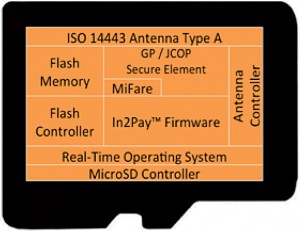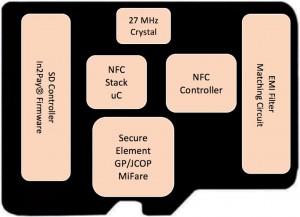Understanding how NFC-enabled microSD can complement card issuance programs as the adoption of mobile payments continues to rise
by Sebastien Tormos, Datacard
 Technology is shaping the future of the financial services industry. A new banking customer is emerging – one who is more tech savvy and holds higher expectations for innovative services and programs. As banks and credit unions aim to provide leading-edge programs that appeal to today’s consumers, one trend they need to consider is NFC adoption for mobile payments.
Technology is shaping the future of the financial services industry. A new banking customer is emerging – one who is more tech savvy and holds higher expectations for innovative services and programs. As banks and credit unions aim to provide leading-edge programs that appeal to today’s consumers, one trend they need to consider is NFC adoption for mobile payments.
The International Telecommunications Union estimates there are currently 6 billion mobile phone subscriptions worldwide. Many of these by Sebastien Tormos, Datacard are smart phones and there is an easy way to make them NFC enabled, by fitting an NFC microSD card into the handset.
It is not a matter of if NFC mobile payments will take off, it is when. When this shift happens, banks and credit unions need to be prepared with technology that can provide mobile payment personalization services up front and develop a program ahead of the competition.
Offering in-branch personalization of NFC mobile payments such as microSDs is a great way to complement card issuance programs and gain a competitive advantage in the marketplace. Financial institutions who can offer consumers a variety of card, contactless and mobile personalization can take advantage of:
- extended reach – transforms mobile phones into a form of payment
- increased market presence – new, flexible ways to pay
- new revenue sources – more transactions means more revenue and profit
- cross-selling opportunities: telcos and banks can work together – co-branding, shared messaging
- improving customer service and convenience levels – improves customer loyalty and competitive/marketing advantage.
Transform
 One example of this is In2Pay technology based on a microSD solution that will transform many smartphones with a memory card slot into an interactive contactless transaction device. Financial institutions, handset manufacturers or mobile network operators can issue the microSD as a credit, debit, prepaid or a multiple account digital wallet. The solution allows these issuers to quickly enable large segments of either a pre-existing installed base or even add new customers with mobile contactless capability. microSD includes an integrated antenna that is optimized for good RF performance across multiple readers and mobile phone models. The read range is typically in the 1cm to 2.5cm range. The microSD controller is SD 1.0/2.0 compliant and is designed to work with almost all memory slot enabled smartphones.
One example of this is In2Pay technology based on a microSD solution that will transform many smartphones with a memory card slot into an interactive contactless transaction device. Financial institutions, handset manufacturers or mobile network operators can issue the microSD as a credit, debit, prepaid or a multiple account digital wallet. The solution allows these issuers to quickly enable large segments of either a pre-existing installed base or even add new customers with mobile contactless capability. microSD includes an integrated antenna that is optimized for good RF performance across multiple readers and mobile phone models. The read range is typically in the 1cm to 2.5cm range. The microSD controller is SD 1.0/2.0 compliant and is designed to work with almost all memory slot enabled smartphones.
The realtime operating system and In2Pay firmware manages the SD interface and also determines whether data coming from the SD interface is meant for the secure element or the flash memory. The secure element embedded within the In2Pay microSD, approved by EMVCo and Global Platform 2.1.1 compliant, supports all relevant crypto algorithms with highest security and performance (DES, AES, ECC GF(p), RSA) with optimized chip crypto HW accelerators.
Furthermore, the microSD includes an integrated antenna that is optimized for good RF performance across multiple readers and mobile phone models. The read range is typically in the 1cm to 2.5cm range. The microSD controller is SD 1.0/2.0 compliant and is designed to work with almost all memory slot enabled smartphones. The realtime operating system and firmware manages the SD interface and also determines whether data coming from the SD interface is meant for the secure element or the flash memory.
NFC functionality
 The SD interface provides the link between the phone and the NFC functionality supported by In2Pay v3.0. Because this technology fully integrates the NFC protocol stack within the microSD, the software overhead to support NFC is minimal. The functionality allows a handset manufacturer to quickly enable NFC on a handset with minimal changes to hardware or software. If the 8-pin SD connector is simply replaced by a 10-pin connector, the additional 2 pins on the connector can be connected to an external antenna either within the handset or embedded within the handset back cover.
The SD interface provides the link between the phone and the NFC functionality supported by In2Pay v3.0. Because this technology fully integrates the NFC protocol stack within the microSD, the software overhead to support NFC is minimal. The functionality allows a handset manufacturer to quickly enable NFC on a handset with minimal changes to hardware or software. If the 8-pin SD connector is simply replaced by a 10-pin connector, the additional 2 pins on the connector can be connected to an external antenna either within the handset or embedded within the handset back cover.
The traditional banking model is evolving and financial institutions need to evolve with it. And, there are new competitors entering the payment landscape every day looking to grab wallet share. Businesses should act now to implement a business model that differentiates them in the marketplace and provides a distinct customer service advantage.
